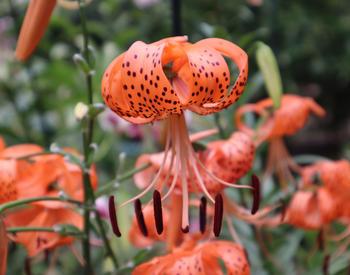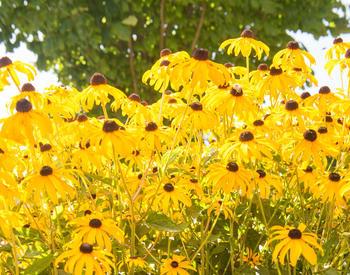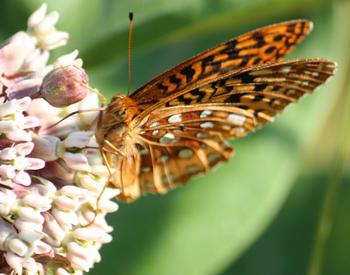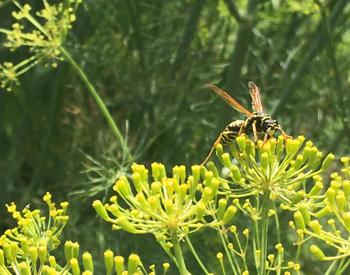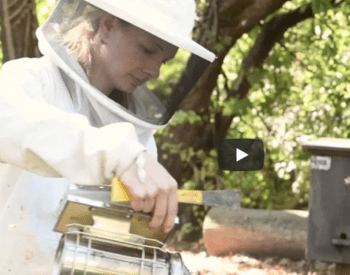Transcript
Speaker 1: From the Oregon State University Extension Service, this is Pollination, a podcast that tells the stories of researchers, land managers, and concerned citizens making bold strides to improve the health of pollinators. I'm your host, Dr. Adoni Melopoulos, assistant professor in pollinator health in the Department of Horticulture. I don't know a lot of people who like mowing their lawns, so when a study comes along and suggests you don't have to mow so frequently and this has the added benefit of helping the bees, well, that's a winning combination.
The question of whether to mow or to mow less was posed by Susanna Lerman and her colleagues in this month's issue of the journal Biological Conservation. I thought it was a great opportunity to convene the OSU research retinue to review the paper. This week's retinue consists of Addison and Neumea who are on the last episode, but also includes Matthew Busey, a special shout out to Isabella Messer who helped a lot with framing this study but is not on the recording and we hope to have her back on a future episode. So rev up those two-stroke motors or not for this lawn mowing and pollinator edition of the OSU research retinue here on Pollination.
Speaker 2: Hello listeners and welcome to research retinue number two. So we're a group of Oregon State University students who are going to analyze papers about bees and make some comments, and questions and raise some points. And so first we're going to all go around and introduce ourselves. We're going to say our name, major, how we're affiliated with this program, and what our favorite Oregon bee is.
So my name is Matthew. I'm a third-year student studying environmental sciences and I am pursuing my undergraduate honors thesis through pollinator health extension here at OSU. And I like all of the bombast bees. So I would say any native Oregonian bombast is good for me.
Speaker 3: Hi, I'm Addison. I'm a biochemistry and molecular biology student at Oregon State and I'm a part of this project because I work for Andoni and my favorite Oregon bee is Anthodium.
Speaker 4: Hi, my name is Umea Wright. My major is in environmental sciences. I'm a freshman here at OSU and I work through the Department of Articulture for Andoni my favorite bee is the bombast. So this article is titled To Mow or To Mow Less. Lawn mowing frequency affects bee abundance and diversity in suburban yards.
Speaker 3: So what they did for this study was they found 16 volunteer lawns and they tested out three different mowing frequencies. So a third of them were randomly chosen to be mowed at one week, a third at two weeks, and a third once every three weeks. Their theory was that mowing less frequently would allow more bees to have flowers and to have a place for habitat to try and mitigate the negative effects of urbanization and the lack of green space that's happened in a lot of cities and suburbs. To ensure that there weren't any huge differences between the lawns, they looked at all the surrounding areas and made sure that the lawns were pretty similar and that they wouldn't have any factors that would influence how many bees or which bee species were there. They also mowed the lawns for the homeowners to make sure that they were done in exactly the right number of days or weeks. Although this was a study that was conducted over two years, in the second year, the lawns that were reused for this study were given a different treatment. They continued this experiment from May through September and then they measured the bee richness, bee abundance, bee evenness, and floral abundance and richness in each of the different treatments of lawn.
Speaker 2: And before we move on to the results of the study or the bees old if you will, we're going to go over just some vocab that we're going to use a lot in this podcast. So kinds metrics of importance for this study and our abundance, richness, and evenness. So like bee abundance would be the number of individual bees of the species. Richness measures how many different species you see. And so two areas could be equally rich and they have an equal number of species represented. But that's where evenness comes in. So one area would have been evenness. If of the species present, there is about an equal number of individuals of each species.
However, if like one species population dominated over the others, that wouldn't exhibit evenness. And so now for the results. Just to go over in general, the bees that were sampled in this project collected almost 5000 bees representing almost 100 species.
I think it was like 93. Most bees seen were small-bodied soil nesting and there was a good amount that were native. The 10 bee species that were the most abundant that were caught represented almost 80% of the bees that were caught when sampling. And apis molyphora, the honey bee only represented 5% of the bee captures.
The most common bees seen were the Lazy Oak Lossum, and the sweat bees, and those were something, I think, around 42% of the amount of bees that were caught. And so how the abundance, richness, and evenness breaks down by treatment. Mowing every two weeks saw the highest bee abundance, but the lowest bee richness and lowest bee evenness, whereas mowing once every week saw the highest richness. And then mowing once every three weeks did see the highest floral abundance, but it didn't see the highest bee abundance or bee richness. Also, site characteristics were taken into account such as like percent bare ground on a lawn or canopy cover. And those weren't significant influencers on things like bee abundance.
Speaker 3: And because of the fact that the lawn mowed every two weeks had the highest bee abundance, the study recommends that that is the ideal treatment for grass that you should mow your lawn once every two weeks, if possible, to help bees. And a lot of the media articles that have picked up this study have agreed with that. So one of the things that we're going to be discussing in this podcast is how we should be measuring if something is helpful for pollinators and if we should base that on abundance or evenness or richness for bees.
Speaker 2: So to raise the first question to my co-hosts, what was your favorite part of the study or what was something you thought the study did really well?
Speaker 4: I like what you were saying earlier, Addison, about how much detail they included in the article. I really appreciate that. Like, I think for future studies, they could use this article as a base for or an outline for new studies.
Speaker 3: Yeah, that was definitely my favorite thing about the study was the amount of detail in their methodology and also in their data collection. There are appendices in this study that list all the different kinds of bees that they found how many of each and in which study. And they were very methodical. And going back to the comment about the methods, there are so many variables when you're considering lawns, even in one suburb, like how big the lawn is, and where it is. And I think the study did an amazing job of trying to factor in all of the different characteristics and make sure that they didn't affect the results at all.
Speaker 2: To add to what has been said, the level of detail in the study was definitely one of my favorite parts, not only in the detail and identifying all the different bees and flower resources encountered, but I really like that they, the different site characteristics that they took into account and how they include those in their analysis to verify that those weren't significant impacts, weren't significant influences on things that are measuring, which really show the potential of lawn management in terms of making an impact on the pollinator community.
Speaker 4: What would be some strategies to use that you think would convince more people to grow their lawns for longer periods of time?
Speaker 3: I think there's something about just saying that, oh, growing your lawn out more could have a positive effect on pollinators that will make people pretty inclined to at least consider it because it is a time-saving. So I think there are a lot of factors that just make it easier to mow your lawn a little bit less. And I think we'll hear this article and be able to use that as further reasoning for why they can mow their lawn less.
Speaker 2: And adding on to that, the environmental potential of this is definitely it could be a strong motivator. I was thinking of people who take a lot of pride in the appearance of their yard and who might feel less inclined to not mow as frequently. And I was thinking people who have very strong goals of theirs to have an aesthetically appealing yard probably also have ornamental flower beds. And so maybe an argument that could be made to them to decrease their mowing frequency would be to emphasize that if there's greater bee abundance on your lawn, that means more pollination services to the flowers that are growing in your flowerbed.
Speaker 4: Is there any possibility that it might be more beneficial not to grow out your lawn?
Speaker 3: So one of the interesting things to me about this study was that actually the frequency that had the highest richness of bees were the lawns that were mowed every week. And I think if you saw a neighborhood as a small sample of an ecosystem and some lawns were mowed every week, some lawns once every two weeks or every three weeks.
And there was variation. I think that would maybe encourage different kinds of bees to go to different lawns and provide a higher diversity in the bee population. Because some bees really like clover flowers, but some bees need the grass to be shorter to find them, especially small sweat bees. And so I think there could be some benefits to having varied lengths of grass, even the grass that's mowed every week, as well as aesthetic benefits.
Speaker 2: I really like the point that was raised. Also, this was brought up in the paper that there are some areas where there are legal ordinances or restrictions on what you can and can't do for your lawn. And so there will be some areas where people can't let their lawn grow out past a certain extent.
Thus the results from the study, they might not, even if they want to implement them, they might not be able to. And so that's kind of something to consider on a case-by-case basis, depending on where you live. But I really like the point brought up about the richness and how having different lengths of grass in a neighborhood could help promote various, it could promote the health of various bee species in the community.
Speaker 4: What could be some minor setbacks about growing out your lawn other than concerns with appearance?
Speaker 3: So I was talking to Andoni earlier and he said that he has a friend who specializes in lawn care, especially for people who don't want to use herbicides. And if you're trying to avoid having clover in your lawn, what you want to do is mow pretty frequently and keep your grass pretty short because it encourages grass to grow, but not the clover.
Speaker 2: And so I think that raises like an important point of when communicating results like this, framing this all integrated lawn management plan, like we're not advocating for abandoning of some strategies in place of others with each like a new recommendation of what to do, but that these are all modifications that could be made together in promoting a healthy ecosystem.
Speaker 4: A point that I thought inspired by the article was educating people on the uses of weeds could change people's ideas on them. Since growing out your grass comes with weeds growing, we have to like remember that weeds are plants and they could have healing properties, medicinal properties, and could even be edible. People growing out their lawns would have easier access to these plants and can become educated on their uses rather than associating weeds with negative connotations.
Speaker 3: I really like that. And I like the idea of being OK with having different things on a lawn other than grass. And I wonder what would it look like if instead of encouraging people to change their grass habits, we said don't grow grass at all, grow something that's more beneficial for bees.
Speaker 2: And I think part of the kind of framework that this paper was operating under is changing mode frequencies could be something that's pretty easily adapted. I think it goes to something like a...
Speaker 3: I agree. I was just laughing because my idea went completely off of that into something very hard to adapt. Oh.
Speaker 2: Yes.
Speaker 3: Well, and that... Something like that could definitely have a really important impact on the pollinator community in your area. I'm just thinking that this is a very, like, for people who care about the issue, it might not have, like, might have a limited time to devote. This could be something pretty easy for them to adapt. Idealism versus practicality. Right.
Speaker 2: This paper and definitely some media articles I've seen that have covered the study itself have really emphasized, like, homeowner lawn care. And I believe in this paper, the definition of lawn includes much more than just something you'd see in a residential area. I believe it included, like, green space and parks or in businesses in a city or even, like, athletic fields. And so I guess I'd post the question, what are your thoughts on changing mowing practices and lawns that aren't... That aren't, like, residential lawns, so in, like, parks or athletic fields?
Speaker 4: So I know growing out, like, your lawn could be a simple fix to grow the bee population if you're a homeowner, but what if you own an apartment and you don't have a lawn? What if you have a porch? Like, what are some simple ways that you can contribute to that?
Speaker 2: And I think that would be a pretty interesting location to study, to see how people could promote, like, bee abundance in that area. Because I'm just thinking of, like, the townhouse that I live in is in, like, a cement island surrounded by other apartment complexes. Like, there's not really green space for, like, a pretty significant distance. And so I think, like, an area further research could be, like, trying to figure out what, like, apartment owners or people who don't have access to their own lawns could do to promote bee abundance and diversity. Because I think, and I would imagine in some areas, like, there would be neighborhoods pretty much, I think it's, like, New York City that are, like, dominated by apartments and there wouldn't be that green space for, like, a significant distance. Thinking of our own campus here in Corvallis, we have a good amount of green space that I don't really know how frequently that's mowed, but I don't know, all the grass seems pretty short. What are your thoughts as to how this could potentially be applied to our campus?
Speaker 3: There's a, I was noticing yesterday, there was a pretty big area of lawn that was, like, pretty long, like, dandelions, flowers that started growing and, like, the English daisies. I don't think it was intentional.
I think somebody just forgot about it, which is fine, good for the bees. But I think there are some spaces like that on this campus. Another thing is Oregon State, for those of you who haven't been here, spent a lot of time on campus, has quite a few plants and areas where plants grow. Like, it's not just concrete.
Speaker 2: Right, we have a good amount of gardens.
Speaker 3: Yeah, and so, like, even just walking to class, like, this week I've been noticing all the flowers and stuff, and I think it's less, like, it would make less of an impact to mowed the lawns a little bit less frequently, just because there's so many other things that the bees can go to. There are huge flowering trees and, like, rhododendrons and, I think, azaleas.
Speaker 4: Well, that's a good point to remind the listeners about, like, if they don't want to stop cutting their lawns and they can grow more flowers that are appealing to the bees, so, or fruit, it's a win-win situation.
Speaker 2: That is a good point that here we do have a good amount of alternative floral resources, although that, and, like, in this study, the lawns mowed once every three weeks had the most floral abundance, but not the most bee abundance.
So, when the, I think the explanation in the paper was that once the grass in the lawn that was mowed least frequently was the longest, and so they, like, sweat bees, which were the most commonly seen, might be too small to navigate through the, through the lawn to reach the flowers. So, be abundance or be richness, which do you all feel is the more important goal to work towards higher richness or higher abundance when talking about promoting a healthy pollinator community?
Speaker 3: And I think, again, it matters which bees are being overrepresented, so if it is honeybees that there's a ton of, that's less desirable than if there are a lot of native bees that maybe are struggling in other places and then find refuge in the lawn in greater amounts than, like, honeybees.
So I think it really depends on, like, a case-by-case basis. Looking at, like, Oregon State campus, for example, I hope that we have a great diversity of bees, and I care about that a lot more than the abundance, but I think that's a little bit different for this study, where they found a ton of native bees that were maybe less likely to go to other areas, whereas, like, bigger bees that can fly farther have different resources.
Speaker 2: But, and I think that's a good point you brought up, Amaya, about the, it's important to know, like, what's growing in your lawn as well when talking about the bee, like, the richness and evenness that you might expect to see.
Speaker 3: Because they found a, like, we've mentioned dandelions and clover, but they ended up finding and identifying a lot of species of plants in the lawns. So, if I, in the first category, 37 species, in the mode, once every two weeks, they identified 28 species and every three weeks, 34 species of plants, which is quite a bit, because when I think lawn, I think grass may be clover, but there's obviously a lot of diversity. And so maybe there are quite a few native plants that are attracting these native bees, which would be good.
Speaker 2: I'm wondering how, so say you lived in a neighborhood, and he had a lawn and he wanted to start mowing less frequently, he wanted to adopt the mowing practice of mowing once every two weeks. I'm wondering, like, I back in Eugene had a lot of neighbors who were honeybee keepers, and I'm wondering if, like, your house was in a neighborhood that was surrounded by a lot of residential beekeepers, how that might, what type of change you'd expect to see just from changing your lawn mowing practices, because I don't remember if in this paper it was brought up if there were, like, residential beekeepers within this neighborhood.
Speaker 4: What if the bees left their lawn and came to your lawn?
Speaker 2: You just got the bees from, like, all the five beekeepers on your street.
Speaker 3: But again, honeybees only made up, what, like, five percent of the bees that they saw and, like, the bees that they attracted? So I don't know, like, maybe, but I'm not convinced that, like, you just have a swarm of bees instantly, like, eight days after mowing your lawn, all the bees just... Right.
Speaker 2: I thought that one of the most interesting things in the results section of the study was that aposmolifera was only five percent of the bees captured out of it if it had been, way more than that.
Speaker 3: I wonder how much of that has to do with the way that they captured bees, because they put out these pan traps, which they noted are a lot better catching the smaller bees, like the Laceo glossum and some of the other small native bees, and then they did hand traps for 15 minutes to try to catch some of the larger bees, and that's where a lot of their diversity was. So I wonder if maybe the larger bees are underrepresented because of that, at least in abundance, if not richness. So maybe there were a ton of aposmolifera, but they just...
Speaker 2: The sampling methods resulted in... So, like, the abundance scene could be partially just a result of the sampling methods chosen. I think it's possible. Actually, I can't remember where it mentions this in the paper, but I believe when it was talking about the bee richness that was witnessed, it mentioned that there was a good degree of, I think they called it singleton captures, which I interpreted as maybe like, the richness went up because they called it bee for menuspecies, but that was the only bee that was seen of that species, and I thought that was pretty interesting. Much of the species richness documented was due to singleton captures, and if I'm interpreting what singleton captures means, I think that adds to your point that I think the choice of sampling methods used in the studies could have had a really big impact on the richness scene. So if you all were to design a study to build off of what was seen in this paper, what's something you'd like to see studied further or to see included?
Speaker 3: I'd want to see a study that covered more areas in different climates with different bees and different plants. So maybe repeat the same study, but in some way with weather vastly different, and just see what the results are.
Like if the grass is going to grow a lot faster, or if bees respond to it differently in any way, and just the effects of that in maybe like, I don't know, a southern climate or somewhere on the west coast.
Speaker 2: Yeah, I guess any closing thoughts, comments, questions, concerns, dissertations, poems, or inspired speeches about this paper?
Speaker 4: I think the paper needs to receive more attention, but I feel like the general public won't have time to very, to look at this article in very much detail and take notes from it. So maybe if people were to start posting on social media, like, I don't know, simple things that will advocate for the message to grow your lawn for two weeks.
Speaker 2: So say you're approached by someone on this, just walking on the street, and they said they heard about the article, but they have no time to read it. And they asked you what's like the most important takeaway. If you could give me one thing to take away from this paper, what would that be?
Speaker 3: Don't go for more than three weeks without mowing your lawn because the grass will get too long and not be a great habitat for bees. It's like my biggest takeaway, which is almost the opposite of theirs, one of their closing statements is to take the lazy lawn mower approach, but the way I read it one and two had more abundance and diversity. And so I think just don't go more than once every three weeks.
Speaker 2: I would say also I might make a, make the note that mowing once every two weeks seems to be ideal for promoting the abundance and then maybe explain like the difference between abundance and richness and like the values of each, but how it's best to have, it's best to have all abundance, richness, and evenness all behind. Good luck.
And this has been research retinue number two. I am Matthew. I'm Addison. I'm Umea. And we're buzzing away. We're signing off. See you next time. Thanks so much for listening.
Speaker 1: Show notes with information discussed in each episode that can be found at pollinationpodcast. orgnstate .edu. We'd also love to hear from you and there are several ways to connect. For one, you can visit our website to post an episode-specific comment, suggest a future guest or topic, or ask a question that could be featured in a future episode. You can also email us at pollinationpodcast at organstate.edu. Finally, you can tweet questions or comments or join our Facebook or Instagram communities. Just look us up at OSU pollinator health. If you like the show, consider letting iTunes know by leaving us a review or rating.
It makes us more visible, which helps others discover pollination. See you next week.
The OSU Research Retinue reviews a research study that garnered a fair amount of press this month on the connection between lawn mowing frequency and bee abundance and diversity. The study, led by Susannah Lerman from USDA Forest Service Northern Research Station, compared the bees visiting lawns mowed weekly, every two or three weeks. The two year study was published in the May issue of the journal Biological Conservation.
This week’s Research Retinue consisted of OSU undergraduates Addison DeBoer (Biochemistry and Molecular Biology), Matthew Bucy (Environmental Sciences) and Umayyah Wright (Environmental Sciences). Special thanks to Isabella Messer (Horticulture) who helped the group research the paper (check out Isabella’s bee blog entries).
You can Subscribe and Listen to PolliNation on Apple Podcasts.
And be sure to leave us a Rating and Review!
“I feel the general public won’t have time to read this paper and it would be great to have a simple message summarizing the findings on social media”. – Umayyah Wright
“So, say you are approached by someone – walking on the street – and they heard about the article but have no time to read it what would you tell them the one important take away of this paper?” – Matthew Bucy
“Don’t go for more that three weeks without mowing your lawn because the grass will get too long for the bees, which almost the opposite of the final line of the paper of taking the “lazy lawnmower” approach. But mowing once a week had more species richness and mowing twice a week had more bee abundance compared to mowing the lawn every three weeks”. – Addison DeBoer
Show Notes:
- How the study was conducted and what was measured
- What the study found was best for bee populations in lawn maintenance
- What key elements are most important in increasing and maintaining pollinator health
- How researchers can improve the study for next time, and what they got right
- Why homeowners should consider changing their mowing habits to better suit pollinator health
- Why this study is very important for busy homeowners
- What people without lawns can do to help the local pollinator habitat
- Which is more important: bee richness or bee abundance
- What the Research Retinue would improve in the next study similar to this one
Links Mentioned:
- Read the article: Lerman, S. B., Contosta, A. R., Milam, J., & Bang, C. (2018). To mow or to mow less: Lawn mowing frequency affects bee abundance and diversity in suburban yards. Biological Conservation, 221, 160-174.
- Check out how different publications covered the study:
- Find out more about using the lawn to benefit pollinators:
